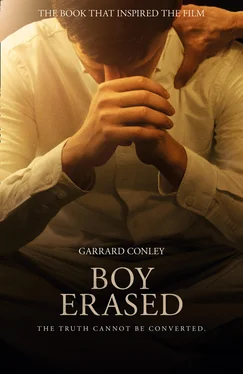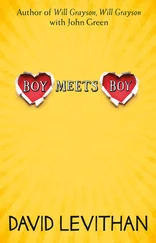Most of us were from the South, most of us from some part of the Bible Belt. Most of our stories sounded remarkably similar. We had all met with ultimatums that didn’t exist for many other people, conditions often absent from the love between parents and children. At some point, a “change this or else ” had come to each of us: Otherwise we would be homeless, penniless, excommunicated, exiled. We had all been too afraid to fall through the cracks; all of us had been told cautionary tales of drug addicts, of sex addicts, of people who ended up dying in the throes of AIDS in some urban West Coast gutter. The story always went this way. And we believed the story. For the most part, the media we consumed corroborated it. You could hardly find a movie in small-town theaters that spoke openly of homosexuality, and when you did, it almost always ended with someone dying of AIDS.
I was here as part of the Source, a two-week trial program meant to determine the length of therapy I would need. Most patients needed at least three months’ residency, usually longer. In many cases, college students like me dropped out of school for at least a year in order to create distance from unhealthy influences. Many stayed even longer. In fact, most of the staff members were former patients who’d been with LIA at least two years, choosing to remain inside the facility rather than reintegrate into their old lives. To be allowed to work at the facility, former patients were expected to find preapproved jobs, support themselves financially, talk only to those whose character and status had been cleared by the staff, and keep clear of the Internet or any other “secular spaces”—including “malls of any kind” or any “non-Christian bookstores.” Because patients weren’t allowed to stray too far from LIA’s offices, the support group became the central focus of patients’ lives, the way and the truth and the light Jesus spoke of in the New Testament, the one true path to God’s love.
Over the next two weeks, LIA staff, along with my parents, would determine what kind of hiatus was necessary in my case. As its name suggested, the Source was the fountainhead of a long and difficult journey.
“TELL THEM what you did, T,” Smid said. We were in the Group Sharing portion of our afternoon session. “You need to admit what you did so it won’t happen again.”
T, an obese middle-aged man wearing several black cardigans, stood before our group to confess, stone-faced, that he had once again attempted suicide.
This was T’s seventh suicide attempt since coming to the program. He’d tried pills, knives, whatever he could find.
“Typical,” J whispered, leaning in, his warm cowboy breath tickling my neck. “The guy’s an attention hog. Got too many daddy issues to name.”
T seemed to shrink into his cardigans, the buried half of him stark black against his pale face. Whatever had first devastated him had left long ago, but LIA would try and dig it up.
“Who among us will cast the first stone?” Smid said, turning back to our group. “We have all sinned and come short of the glory of God.”
It seemed earnestness was more than half the battle in the fight for an ex-gay lifestyle. You had to want to change, and until you wanted to change so badly that you’d rather die than not change, you would never make it past Step One—admitting you were wrong. The reason pre–ex-gays like T felt powerless to change, Smid said, was that deep-seated family issues kept them separate from God. “Suicide isn’t the answer,” he said. “The answer is God. Plain and simple.”
“What I did was wrong,” T said, pocketing his pink-scarred hands inside his topmost cardigan, his words scripted. “I know that with God’s help I can learn to see the value in my life.”
J coughed a laugh into the hollow of his fist. Don’t count on it .
When T finally sat down, we all said, “I love you, T.” It was a program requirement, rule number nine in the Group Norms section: Once someone from your group stops talking, say “I love you, ________. ”
All of God’s children being equal, our names were interchangeable.
“I love you, T,” Smid said.
ALTHOUGH I didn’t know it at the time, Smid had given different advice before. He was still dealing with a decade-long backlash that had arisen from alleged advice he’d given to one of the first young men to attend his program. According to Family & Friends , a Memphis newspaper, Smid had told the man that it would be better for him to kill himself than to live as a homosexual.
Various bloggers have since approximated the number of suicides resulting from LIA’s treatment as anywhere from twenty to thirty cases, though figures like these are impossible to pin down.
The controversy didn’t end there. According to a Daily Beast interview with Peterson Toscano, a former patient of Smid’s who attended LIA meetings in the late ’90s, LIA had also been responsible for staging a mock funeral for a “would-be defector,” a young man of nineteen or twenty who felt he might benefit from an openly gay lifestyle outside the facility. LIA members stood before the boy’s reposing body and spoke about “how terrible it was that he didn’t stick with God, and now look where he is, he’s dead because he left.” They read mock obituaries that described the boy’s rapid descent into HIV, then AIDS, and cried over him. This went on until the boy was fully convinced that his sinful behavior would lead him to a death without any hope of resurrection. Though the boy did finally flee LIA, it was only years later and, according to a conversation I had with Toscano, only after years of psychological damage.
It was our fear of shame, followed by our fear of Hell, that truly prevented us from committing suicide.
SMID FINISHED his speech and waited in silence for our faces to register the importance of Step One. After several long seconds, he dismissed us for a break, cupping his palms together for a single clap. The sound was jarring. I stood and stretched, then walked through the sliding glass door and kept walking across the porch, feeling like I could walk for hours, days, weeks. The others followed, their shoes scratching the concrete.
I wanted to talk more with J, who seemed like a nice-enough guy, someone who hadn’t been here long enough to forget what the first day was like. But J stayed seated inside, and I ended up standing at the far edge of the porch by myself. I could see S standing just on the other side of the glass, straightening her skirt and aiming the corner of a shy smile in my direction. T was still sitting at the end of our semicircle, his gaze fixed on a patch of concrete near my feet, where a few tawny birds pecked at crumbs left behind by one of the group members. He cupped his hands in front of him as though they were filled with birdseed, as though he might scatter a pecking trail from the door to his chair.
“NOW,” SMID SAID, walking over to a whiteboard on the opposite wall, “can anyone here tell me what a genogram is?” He clapped his hands together. “Anyone?” He picked up a black dry-erase marker from the silver tray at the bottom of the whiteboard.
S straightened her shoulders and raised one hand, the other hand tugging her skirt below the red knobs of her knees—what I would soon learn were rules two, four, and six of the Group Norms section of our handbooks: “(2) No slouching in chairs, sitting back on chairs’ hind legs, sitting with arms crossed, rolling eyes, or making disgusting faces; (4) Raise hands to speak; (6) Clients are to sit in such a way as to not cause another to stumble.” She’d obviously been here long enough to tame most of her False Images.
“Yes?” Smid said.
“A genogram is a family tree,” she said, “only one that shows patterns of family history as well. Kind of like an illustrated genealogy.” Or a character list , I thought, remembering the many hours I’d spent in my dorm room trying to chart the family history of Wuthering Heights in my Moleskine, annotations like “the meaner Cathy” written beside characters’ names. I wondered if I’d get my notebook back.
Читать дальше












